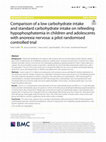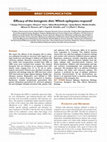Papers by Kellie A Draffin

Journal of Eating Disorders
Background Nutritional rehabilitation for patients with anorexia nervosa involves balancing the n... more Background Nutritional rehabilitation for patients with anorexia nervosa involves balancing the need for weight gain whilst mitigating the risk of refeeding syndrome. Graded caloric increases and restriction of calories from carbohydrate have been used to minimise the risk of developing refeeding hypophosphatemia. There is little evidence to support the recommended nutrient composition, specifically the recommended carbohydrate intake that is safe in this population. The aim of this pilot study was to compare the effect of a low and a standard carbohydrate feeding protocol on serum phosphate levels in children and adolescents with anorexia nervosa. Methods A pilot study of 23 children and adolescents with anorexia nervosa admitted for medical stabilisation to the adolescent ward of a tertiary hospital was undertaken. Participants were commenced on an oral feeding protocol and were randomly allocated to isocaloric meal plans that were either low carbohydrate (
Journal of Eating Disorders, 2014

Bone Abstracts, 2013
The ketogenic diet (KD) is a medically supervised, high fat, low carbohydrate and restricted prot... more The ketogenic diet (KD) is a medically supervised, high fat, low carbohydrate and restricted protein diet which has been used successfully in patients with refractory epilepsy. Only one published report has explored its effect on the skeleton. We postulated that the KD impairs skeletal health parameters in patients on the KD. Patients commenced on the KD were enrolled in a prospective, longitudinal study, with monitoring of Dual-energy X-ray absorptiometry (DXA) derived bone parameters including bone mineral content and density (BMD). Areal BMD was converted to bone mineral apparent density (BMAD) where possible. Biochemical parameters, including Vitamin D, and bone turnover markers, including osteocalcin, were assessed. Patients were stratified for level of mobility using the gross motor functional classification system (GMFCS). 29 patients were on the KD for a minimum of 6 months (range 0.5-6.5 years, mean 2.1 years). There was a trend towards a reduction in lumbar spine (LS) BMD Z score of 0.1562 (p=0.071) per year and 20 patients (68%) had a lower BMD Z score at the end of treatment. While less mobile patients had lower baseline Z scores, the rate of bone loss on the diet was greater in the more mobile patients (0.28 SD loss per year, p=0.026). Height adjustment of DXA data was possible for 13 patients, with a mean reduction in BMAD Z score of 0.19 SD. Only two patients sustained fractures. Mean urinary calcium-creatinine ratios were elevated (0.77), but only 1 patient developed renal calculi. Children on the KD exhibited differences in skeletal development that may be related to the diet. The changes were independent of height but appear to be exaggerated in patients who are ambulant. Clinicians should be aware of potential skeletal side effects and monitor bone health during KD treatment. Longer term follow up is required to determine adult/peak bone mass and fracture risk throughout life.
Journal of Eating Disorders, 2013

Epilepsia, 2012
We report the efficacy of the ketogenic diet in refractory epilepsies focusing on outcomes with r... more We report the efficacy of the ketogenic diet in refractory epilepsies focusing on outcomes with regard to epilepsy syndromes and etiology in children and adults with refractory epilepsy. Sixty-four consecutive children and four adults were prospectively enrolled from 2002 to 2009; seven were excluded from analysis. The classical ketogenic diet was initiated on an inpatient basis with dietary ratios ranging from 2:1 to 4:1 fat to carbohydrate and protein. Patients were classified according to syndrome and etiology using the 1989 and more recent 2010 International League Against Epilepsy (ILAE) classification systems. Responders were defined as >50% reduction in seizure frequency compared to baseline. Syndromes included symptomatic generalized (52), genetic (idiopathic) generalized , and focal epilepsies (2) and etiologies included structural (24), genetic (18), and unknown . Twenty-nine (48%) of 61 patients were responders at 3 months. Two children became seizure-free: one with focal epilepsy of unknown etiology and another with refractory childhood absence epilepsy. Responsive syndromes included migrating partial epilepsy of infancy, childhood absence epilepsy, focal epilepsy, epilepsy with myoclonic-atonic seizures, and Dravet syndrome. Children with lissencephaly and hypoxic ischemic encephalopathy had surprisingly good responses. The ketogenic diet is an effective treatment for children and adults with refractory epilepsy. The response is predicted by type of epilepsy syndrome. Accurate characterization of the electroclinical syndrome is an important factor in decisions about timing of initiation of the ketogenic diet.
Journal of Eating Disorders, 2014
Uploads
Papers by Kellie A Draffin